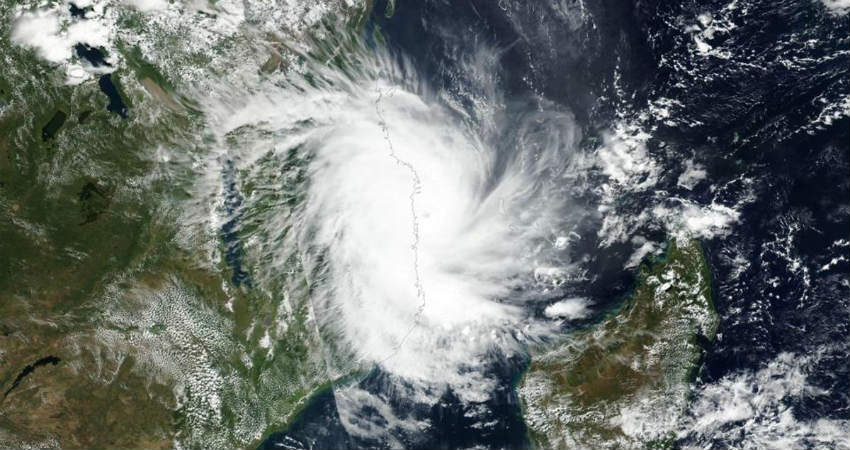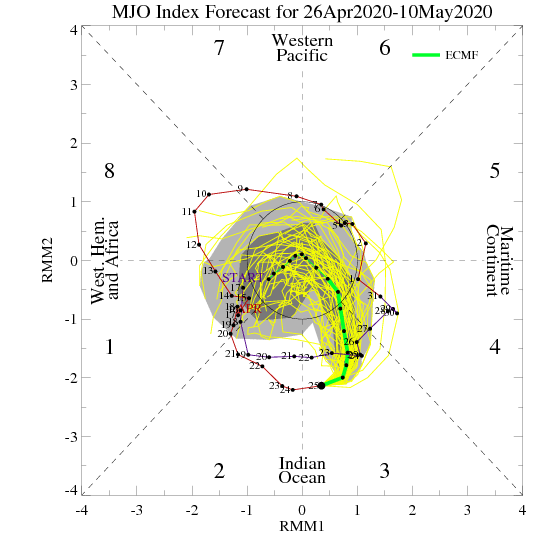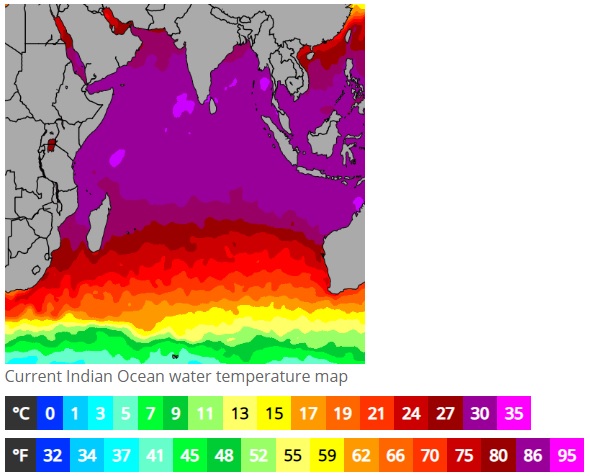
Updated on May 18, 2020 5:30 PM IST: Extremely Severe Cyclone Amphan intensifies to Super Cyclonic Storm
The Super Cyclone Amphan is moving over west-central and adjoining central parts of the South Bay of Bengal near latitude 13.7°N and longitude 86.2 °E. Super Cyclonic Storm Amphan is about 730 km nearly south of Paradip (Odisha), 890 km south-southwest of Digha (West Bengal) and 1010 km south-southwest of Khepupara (Bangladesh). It is very likely to move nearly northwards for some more time and then north-northeastwards across the northwest Bay of Bengal and cross West Bengal – Bangladesh coasts between Digha (West Bengal) and Hatiya Islands (Bangladesh) during the Afternoon / Evening of 20th May 2020 as an Extremely Severe Cyclonic Storm with maximum sustained wind speed of 165-175 kmph gusting to 185 kmph.
Updated on May 18, 2020 9:30 AM IST:
Very Severe Cyclonic Storm Amphan has rapidly intensified into an Extremely Severe Cyclonic Storm and is centered over central and adjoining South Bay of Bengal, around 13Nand 86E. The cyclone is moving north and intensifying further. Clearly marked EYE with dimensions of about 20km diameter is proving it might. The cyclone will remain in the open and deep waters of Bay of Bengal under favorable environmental conditions.
Updated on May 18, 2020 8:00 AM IST:
Very Severe Cyclonic Storm, Amphan is over the central Bay of Bengal and is centered around 13N and 86.2E, about 800km south of Paradip and 950km SSW of Digha. The storm has moved nearly northward in the last 12 hours with a speed of about 12kmph. Cyclone Amphan is likely to move NNE now and also intensify into an Extremely Severe Cyclonic Storm in the next about six hours. The storm has developed a very compact and clearly marked EYE, as a mark of its strength. The storm is packed with winds of 150kmph and gusting to 170kmph. The cyclone is likely to cross the West Bengal-Bangladesh border between Digha and Hatia on 20th May.
Updated on May 17, 2020 6:00 PM IST:
Cyclone Amphan has rapidly intensified into a Very Severe Cyclonic Storm (VSCS). The storm is now centered around 11.6N and 86E, about 950 km south of Paradip and1250 km SSW of Kolkata. It will be moving nearly north for some time and then recurve to move northeast. Likely to intensify further to Extremely Severe Cyclonic Storm (ESCS) in the next 24hr. The cyclone is likely to make landfall on 20th May, in the bordering area of West Bengal and Bangladesh.
Updated on May 17, 2020 12:30 PM IST: Cyclone Amphan intensified to severe cyclonic storm
Cyclone Amphan has intensified to a severe cyclonic storm over the west central Bay of Bengal. It has moved slowly northwest in the past 12 hours and is centered about 1250 km SSW (southsouthwest) of Kolkata and 950km south of Paradip. The storm will start moving northward initially and then NNE (northnortheast). Likely to become Very Severe Cyclonic Storm (VSCS) by today evening and Extremely Severe Cyclonic Storm(ESCS) in the subsequent 24 hours. It is likely to make landfall on the 20th May morning, close to West Bengal - Bangladesh border. Adverse weather conditions with high velocity winds more than 120 kmph and extremely heavy rains are likely along and off Odisha-West Bengal coast between 18th and 20th May. Red Alert is sounded for the two states to observe utmost safety and precautions.
Updated on May 16, 2020 6:00 PM IST: Depression in Bay of Bengal intensified to Deep Depression
The deep depression in the Bay of Bengal has intensified into a cyclonic storm. The maiden cyclone, cyclone Amphan, of this season is centered around 10.5N and 86.4E, about 650km ESE (East South East) of Chennai. The system remains in favorable environmental conditions and will shortly intensify further to a severe cyclonic storm.
Landfall is expected on May 19th late night or 20th morning, Southeast of Kolkata, subject to revision. The storm will have catastrophic damaging potential with extremely heavy rains and high-velocity winds, along with and off the coast of Odisha and West Bengal.
Updated on May 16, 2020 11:30 AM IST: Depression in Bay of Bengal intensified to Deep Depression
The depression in the Bay of Bengal has intensified to a deep depression, centered around 10.5N and 86.8E. The system continues to be in favorable environment and is likely to burgeon to a significant cyclone in the next few hours, earlier than expected. The deep depression is presently located about 850km SSE of Visakhapatnam and 1100 km south of Paradip, Odisha. The system will move northwest and reach abeam Chennai, keeping a safe distance of about 600km by this evening, as a developed cyclonic storm. Thereafter, it is likely to move northward and intensify to a severe cyclonic storm in the subsequent 24 hours.
Updated on May 15, 2020 1:20 PM IST:
The well marked low pressure area southeast Bay of Bengal has intensified into a depression. The system is centered around 10.6N and 87.3E, about 900km southeast of Visakhapatnam. The depression is moving northwest and remains in a favorable environment for further development. It is likely to become a cyclonic storm by tomorrow and reach abeam Chennai at a safe distance of approximately 600km. The storm thereafter will be moving initially north and then northnortheast (NNE) and strengthen further to a severe cyclonic storm. Extreme northern parts of coastal Odisha and West Bengal will run the risk of direct impact around 19th May.
Updated on May 14, 2020 1:40 PM IST:
The first cyclone of this season in the Indian Seas is few knocks away. Existing low pressure area in the southeast Bay of Bengal is well marked and is poised to become 'depression' within next 24 hours. The system is in favorable environment for intensification to a cyclonic storm latest by 16th May. Though the cyclone will take a recurvature northward while over the westcentral Bay of Bengal, abeam Chennai, but the orientation of our coastline will engage the storm to make a landfall, tentatively around 18-19th May. More confident forecast can be expected after another 24 hours.
Updated on May 12, 2020 7:15 PM IST:
The meteorological conditions in the southeast Bay of Bengal are furthering significant development within the next few days. The cloud configuration and the wind field is indicating likely formation of a low-pressure area over the Andaman Sea and the southeast Bay of Bengal in the next 24-36 hours. MJO is shifting closer again to be in phase 2 & 3 over the Indian Ocean from 12th to 18th May. Though the amplitude will be marginal but still good enough to enhance the convective activity over the Bay of Bengal during this period. The turbulent conditions over the region are making the data assimilation for weather models difficult. There is consensus about likely cyclogenesis in this area from 15th May onward, however, the diversity among the most numerical models still remains about the location, track, and severity of the system. Accordingly, the entire region is kept under observation for any further development.
Updated on May 10, 2020 4:30 PM IST:
The cyclonic circulation over the southeast Bay of Bengal and the Andaman Sea persists. It appears more organized and the convective cloud cluster is also shaping up around this feature. Sea Surface Temperature (SST) of about 31 degrees carries sufficient heat potential. But the gain from the SST is getting erased by moderate wind shear and there is nil support from the MJO which is languishing far from the area of action. However, there is no existential threat and the conditions look good towards formation of a low pressure area in the next 72 hours. Weather models diversity remains for its further intensification, area and track. In pursuant of favorable environmental conditions, the area is kept under observation over the next 03 days for any further development.
Updated on May 08, 2020 8:30 PM IST:
The cyclonic circulation over Bay of Bengal persists and is now marked over South Andaman Sea and adjacent waters of Sumatra Island. Warm and moist air continue to swirl around the area filled with large size convective clouds. Weather models continue to be diverse with prospects of any significant development. Though none of them suggest any immediate cyclogenesis over the region but few of them indicate formation of Low Pressure within a week over South and southwest Bay of Bengal. With environmental conditions still favorable, the area is kept under observation for the next 3 days.
Updated on May 07, 2020 8:30 PM IST:
The cyclonic circulation, as a remnant of an erstwhile low-pressure area over the southeast Bay of Bengal persists. A fresh vortex as a cyclonic circulation is likely to form over the southwest Bay of Bengal in the next 48 hours. Under the combined influence of these two systems, a well-marked cyclonic circulation is most likely over the South Bay of Bengal around 11th May. Chances of its further development remain good. There is diversity amongst various weather models about its intensification and track. Therefore, the region is kept under observation for the next 3-4 days.
Updated on May 06, 2020 5:45 PM IST:
The low pressure area persisting for the last few days over the Andaman Sea and Southeast Bay of Bengal has weakened now. However, the cyclonic circulation continues to be marked in the same region. The equatorial belt in the proximity of this systems seems to become active. ITCZ is marked from Sumatra to Maldives across equatorial Indian Ocean. There are indications of another vortex (cyclonic circulation) forming over the Southwest Bay, off Sri Lanka coast in the next 48 hours. The combined influence of these two could give rise to a significant weather system. The complete region, therefore, remains under observations over the next 4-5 days for any further development.
Updated on May 05, 2020 8:30 PM IST:
The low pressure area persists over the South Andaman Sea and the adjoining Southeast Bay of Bengal. There is no change in the status of this weather system. The MJO has already moved away from the Indian Ocean and therefore will not support its intensification. Most of the weather models also are not suggesting any further strengthening in the next 3-4 days. Following this, some changes are likely and so the region is kept under observational watch for the next 5 days for any further development.
Updated on May 04, 2020 6:30 PM IST:
Low pressure area over the South Andaman Sea and the Southeast Bay of Bengal persists. The system is turning and twisting over the same region in the last 24 hours. There are no signs of immediate intensification or deflation as well. The system is likely to hold ground for the next 72 hours, though with a slight and gradual shift northwestward. More it stays over the sea with signs of persistence, better are the chances for its subsequent strengthening. The whole area is under observational watch for any further development.
Updated on May 03, 2020 5:00 PM IST:
The low pressure area over the Southeast Bay of Bengal and the South Andaman Sea persists. The system has neither shown any significant movement and nor any intensification in the past 24 hours. In the meantime, MJO's amplitude is reducing as well as shifting shortly to phase 5 and 6 away from Indian Ocean. The vertical wind shear has marginally increased over the area of low pressure. Sea Surface Temperature continues to be adequately warm. Under these conditions, no major changes are expected in the next 72 hours. However, the region remains favorable for significant development thereafter.
Updated on Apr 29, 2020 2:00 PM IST:
A cyclonic circulation has formed over the equatorial Indian Ocean and adjoining South Andaman Sea. The presence of a cloud cluster in that area suggests the formation of low pressure in the next 24-36 hours. The favorable environmental condition indicates the further strengthening of depression in the subsequent 48 hours. Initially, it will keep moving northwestward and also linger a little longer in the sea to intensify to a cyclonic storm. Probability of the cyclone to recurve while over Southcentral Bay and head towards Myanmar/ Bangladesh stand good.
Updated on Apr 28, 2020 8:00 PM IST:
Indian seas go on watch for stormy weather during Pre-Monsoon. The season as such commences in March to last till June, but April and May remain favorite for storm formation. March more often gives amiss as only 4 feeble storms have formed in the last 120 years. May stands double the chance of April for storm formation in either of the basin i.e. the Bay of Bengal and the Arabian Sea. The year 2019 saw 9 storms in the Indian Seas and 'Pawan' was the last storm in December 2019 in the Arabian Sea.
The naming of storms in the Indian seas started in 2004. Eight countries around the Indian Ocean rim in the Northern Hemisphere prepared eight lists contributing 8 names each. The respective countries are Bangladesh, India, Maldives, Myanmar, Oman, Pakistan, Sri Lanka, and Thailand. The first named storm 'ONIL' formed in the Arabian Sea between Sep 30 - Oct 10, 2004, threatening the Gujarat coast. Out of the 64 names generated in the first lot, 63 have been used and the last in the list 'AMPHAN' named by Thailand is waiting in the wings to be used shortly. After this, the fresh list is likely to come up for the ongoing cyclone season.
The Bay of Bengal is taking the lead and preparing to host the first storm of the season anytime soon. A cyclonic circulation is forming in the North Andaman Sea on the 28th of April. This will get organized and induce a low pressure on April 29th over the same region. Subsequently, the system will move northwestward and intensify into depression or deep depression on May 01st. The system will be strengthening further to a cyclonic storm on May 2nd while lying over the Southeast and adjoining Southcentral Bay of Bengal. Here on the storm will start moving northward initially, intensify further to a Severe Cyclonic Storm and recurve to head for Myanmar and Bangladesh coast.
The oceanic conditions seem to be favorable for the first storm of the season. MJO (Madden Julian Oscillation) will be in phase 3 over the Indian Ocean till May 5th, albeit with reducing amplitude but adequate to stimulate the convective activity further.

Also, the SST (Sea Surface Temperature) is in excess of 30 degrees supporting enough heat potential over the entire area of influence of storm. Another factor favoring the growth and sustenance of the weather system is low to moderate vertical wind shear.

The inception stage of the storm is going to cause copious rains and strong winds over the entire chain of Bay Islands. The maiden cyclone AMPHAN is likely to remain at a safe distance from the mainland. Initial track prediction suggests it to be heading for Myanmar and Bangladesh anytime around May 4th, 2020.


